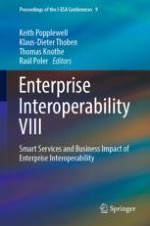This book gathers the proceedings of the I-ESA’18 Conference, which was organised by the Fraunhofer IPK, on behalf of the European Virtual Laboratory for Enterprise Interoperability (INTEROP-VLab) and the DFI, and was held in Berlin, Germany in March 2018. It presents contributions ranging from academic research and case studies, to industrial and administrative experiences with interoperability that show how, in a globalised market scenario – where the ability to cooperate with other organisations efficiently is essential in order to remain economically, socially and environmentally cost-effective – the most innovative digitised and networked enterprises ensure that their systems and applications can interoperate across heterogeneous collaborative networks of independent organisations. Furthermore, the content addresses smart services, and the business impact of enterprise interoperability on organisations.
Many of the papers in this ninth volume of the I-ESA Conference proceedings include examples and illustrations to help deepen readers’ understanding and generate new ideas. Offering a detailed guide to the state of the art in systems interoperability, the book will be of great value to all engineers and computer scientists working in manufacturing and other process industries, and to software engineers and electronic and manufacturing engineers working in academic settings.
